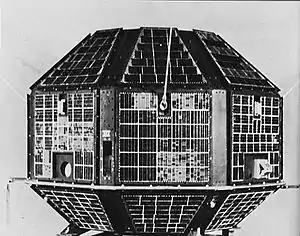This is a list of Indian Space Research Organisation (ISRO) missions. ISRO has carried out 125 spacecraft missions, 92 launch missions[1] and planned several missions including[2] the Gaganyaan (crewed/robotic) and Interplanetary mission such as Lunar Polar Exploration Mission, Chandrayaan-4, Shukrayaan and Mangalyaan-2 (MOM 2).
Completed missions
Lunar
| Mission Name | Start date | End date | Details | |
|---|---|---|---|---|
| Chandrayaan programme | Chandrayaan-1 | 22 October 2008 | 28 August 2009 | Chandrayaan 1 as India's first lunar probe. It was launched by the Indian Space Research Organisation on 22 October 2008, and was operated until August 2009. The mission included a lunar orbiter and an impactor. The mission was a major boost to India's space program, as India researched and developed its own technology in order to explore the Moon. The vehicle was successfully inserted into lunar orbit on 8 November 2008.[3][4] |
| Chandrayaan-2 | 22 July 2019 | Orbiter functional; the lander crashed onto Moon's surface due to loss of control (caused by a software glitch) during the final phase of descent.[5] | Chandrayaan-2 was launched from the second launch pad at Satish Dhawan Space Centre on 22 July 2019 at 2:43 PM IST (09:13 UTC) to the Moon by a LVM3 (previously known as GSLV Mk III). The planned or by bit has a perigee of 169.7 km and an apogee of 45475 km. It consists of a lunar orbiter, lander and rover, all developed in India. The main scientific objective is to map the location and abundance of lunar water. | |
| Chandrayaan-3 | 14 July 2023 | 10 November 2023 (Orbiter exited lunar sphere of influence) | Chandrayaan-3 was launched from the Satish Dhawan Space Centre, Sriharikota on 14 July 2023 at 14:35 IST (UTC +5:30) by LVM3 M4. The main scientific objective is to demonstrate end-to-end capability in safe landing and roving on the lunar surface. The Chandrayaan-3 successfully landed on moon on 23 August 2023 at 18:05 IST (UTC +5:30). For technology demonstration experiments, hop experiment on the Vikram Lander was conducted and the Propulsion Module (PM) of Chandrayaan-3 was moved from an orbit around Moon to an orbit around Earth.[6] | |
Solar
| Mission Name | Start date | End date | Details |
|---|---|---|---|
| Aditya-L1 | 2 September 2023 | TBD |
Aditya-L1 is the first Indian observatory class mission to study the solar corona using a solar coronagraph and also chromosphere using near UV instrument. X-ray spectroscopic instruments will provide flare spectra while the in-situ payload observes the solar events during their passage from Sun to Earth.[7] On 6 January 2024, Aditya-L1 spacecraft, India's first solar mission, has successfully entered its final orbit around the first Sun-Earth Lagrangian point (L1), approximately 1.5 million kilometers from Earth.[8]
|
Interplanetary
| Mission Name | Start date | End date | Details |
|---|---|---|---|
| Mars Orbiter Mission | 5 November 2013 | 2 October 2022 | Mars Orbiter Mission (MOM), also called Mangalyaan, is a spacecraft orbiting Mars since 24 September 2014. It was launched on 5 November 2013 by the Indian Space Research Organization (ISRO). It is India's first interplanetary spaceflight mission and ISRO has become the fourth space agency to reach Mars, after the Soviet space program, NASA, and the European Space Agency. India is the first Asian nation to reach Mars orbit, and the first nation in the world to do so in its first attempt.[9][10] |
Astronomy
| Mission Name | Start date | End date | Details |
|---|---|---|---|
| ASTROSAT | 28 September 2015 | completed in September 2022 | ASTROSAT is the first dedicated Indian Astronomy satellite mission launched by ISRO on 28 September 2015, which enabled multi-wavelength observations of the celestial bodies and cosmic sources in X-ray and UV spectral bands simultaneously. It was in the Sun's orbit for 7 years. The scientific payloads cover the Visible (3500–6000 Å...), UV (1300–op Å...), soft and hard X-ray regimes (0.5–8 keV; 3–80 keV). The uniqueness of ASTROSAT lies in its wide spectral coverage extending over visible, UV, soft and hard X-ray regions.[11] |
| X-ray Polarimeter Satellite | 1 January 2024 | Space observatory | The X-ray Polarimeter Satellite (XPoSat) is a ISRO space observatory to study polarization of cosmic X-rays. It was launched on 1 January 2024 on a Polar Satellite Launch Vehicle (PSLV-C58).[12][13] XPoSat will study the 50 brightest known sources in the universe, including pulsars, black hole X-ray binaries, active galactic nuclei, and non-thermal supernova remnants.[14][15] |
Planned missions
| Mission name | Expected launch | Spacecraft | Details |
|---|---|---|---|
| INSAT-3DS | 26 January 2024 | Communications satellite | INSAT series ("INSAT-3DS") communications satellite (jointly made and operated by ISRO). It is part of the Indian National Satellite System (INSAT) series, which serves various communication, broadcasting, and meteorological purposes across India and neighboring regions. INSAT-3DS will provide meteorological imaging and data relay services, aiding weather forecasting, disaster management, and other related activities. Its contributions will include weather monitoring, cyclone detection, and facilitating communications during natural disasters. |
| NISAR | 30 March 2024 | SAR satellite | NASA-ISRO Synthetic Aperture Radar (NISAR) is a joint project between NASA and ISRO to co-develop and launch a dual-frequency synthetic aperture radar satellite to be used for remote sensing. It is notable for being the first dual-band radar imaging satellite.[16] |
| Gaganyaan 1 | 2024 | Test flight (uncrewed) | Gaganyaan ("Orbital Vehicle") is an Indian crewed orbital spacecraft (jointly made by ISRO and HAL) intended to be the basis of the Indian Human Spaceflight Programme. The spacecraft is being designed to carry three people, and a planned upgraded version will be equipped with rendezvous and docking capability. This will be the first of two flight tests prior to the inaugural of crewed mission. |
| Gaganyaan 2 | Mid 2025 | Test flight (uncrewed) | Second of two flight tests prior to the inaugural crewed mission. |
| Venus Orbiter Mission
(Shukrayaan) |
December 2025 | Venus orbiter | The Indian Venus orbiter mission is a planned orbiter to Venus by the Indian Space Research Organization (ISRO) to study the atmosphere of Venus. |
| Mars Orbiter Mission 2 | 2026 | Mars orbiter | Mars Orbiter Mission 2 (MOM 2) also called Mangalyaan 2 is India's second interplanetary mission planned for launch to Mars by the Indian Space Research Organization (ISRO) in the 2021–2022 time frame. It will consist of an orbiter, as said by ISRO chairman, K. Sivan in an interview, but chances were that it will also include a lander and a rover but later it was fully confirmed that it will an orbiter mission only[17] |
| Gaganyaan 3 | 2026[18] | Crewed spacecraft | First crewed Gaganyaan mission. If successful, India would become the fourth country in the world (after the US, Soviet Union and China) to independently send humans in space. |
| Lunar Polar Exploration Mission | 2026 | Lunar lander, rover | Lunar Polar Exploration Mission is a concept mission by JAXA and ISRO to explore the south pole region of the Moon in 2025. The mission concept has not yet been formally proposed for funding and planning. |
| Chandrayaan-4 | 2028[19] | Lunar lander, sample return | Chandrayaan-4 is a planned lunar sample-return mission of the Indian Space Research Organisation (ISRO) and will be the fourth iteration in its Chandrayaan programme. It consist of four modules namely Transfer module (TM), Lander module (LM), Ascender module (AM) and Reentry Module (RM). |
| Bharatiya Antariksha Station | 2028–2035 | Space station | The Bharatiya Antariksha Station (referred in the media as Indian Space Station) is a planned space station to be constructed by India and operated by the (ISRO). The space station would weigh 20 tonnes and maintain an orbit of approximately 400 kilometres above the Earth, where astronauts could stay for 15–20 days. |
| AstroSat-2 | TBD | Space telescope | AstroSat-2 is India's second dedicated multi-wavelength space telescope, proposed by the Indian Space Research Organization (ISRO) as the successor of the current Astrosat-1 observatory. ISRO launched an 'Announcement of Opportunity in February 2018 requesting proposals from Indian scientists for ideas and the development of instruments for astronomy and astrophysics. |
Other missions
There are also various Indian satellite which contain science related instruments as secondary payloads. The main objective of these satellites are not Space Science. For example an X-ray payload was flown aboard Aryabhatta, the first Indian satellite.
The STS-51-B Space Shuttle Challenger mission consisted of Anuradha, an Indian Cosmic Ray Experiment. It consisted of a Barrel shaped recorder consisting of plastic sheets. It detected cosmic rays at the rate of seven a minute for 64 hours and produced 10000 sheets of data.
In the SROSS-C2, satellite of the Stretched Rohini Satellite Series, a Gamma-ray burst detector was flown.
See also
References
- ↑ "list of missions".
- ↑ "ISRO Upcoming Space Missions and Launches 2023". Hindustan Times. 21 December 2022. Retrieved 12 April 2023.
- ↑ "Chandrayaan-1".
- ↑ "Chandrayaan-1". Archived from the original on 14 November 2007.
- ↑ "How did Chandrayaan 2 fail? ISRO finally has the answer". The Week. 16 November 2019. Archived from the original on 24 August 2023. Retrieved 17 November 2023.
- ↑ "Returns to home Earth: Chandrayaan-3 Propulsion Module moved from Lunar orbit to Earth's orbit". www.isro.gov.in. Retrieved 4 December 2023.
- ↑ Marar, Anjali (28 April 2021). "ARIES to train next-generation solar scientists ahead of India's Aditya L1 mission". The Indian Express. Retrieved 21 August 2021.
- ↑ "Halo-Orbit Insertion of Aditya-L1 Successfully Accomplished". www.isro.gov.in. Retrieved 6 January 2024.
- ↑ "Mars Orbiter Mission Spacecraft".
- ↑ "Mars Orbiter Mission".
- ↑ "PSLV Successfully Launches India's Multi Wavelength Space Observatory ASTROSAT". Archived from the original on 30 September 2015.
- ↑ "Isro's PSLV-C58 XPoSat mission successful; satellite set to study X-ray emissions from black holes and other celestial objects". The Times of India. 1 January 2024. ISSN 0971-8257. Retrieved 1 January 2024.
- ↑ "PSLV-C58 XPoSat: India successfully launches satellite to study black holes from Sriharikota". Hindustan Times. 1 January 2024. Retrieved 1 January 2024.
- ↑ "PSLV-C58 XPoSat: Why did ISRO launch X-Ray polarimetre satellite? What's the mission objective?". Hindustan Times. 1 January 2024. Retrieved 1 January 2024.
- ↑ "PSLV-C58 / XPoSat Mission". www.isro.gov.in. Retrieved 1 January 2024.
- ↑ "NISAR". nasa.com.
- ↑ "Isro says India's second Mars mission Mangalyaan-2 will be an orbiter mission". India Times. 20 February 2021. Retrieved 12 April 2023.
- ↑ Dutt, Anonna (9 April 2023). "Gaganyaan: From astronauts' training to tech upgrade, ISRO making leaps to meet 2025 target for manned mission". The Indian Express. Retrieved 10 April 2023.
- ↑ IITM Foundation Day 17th Nov 2023, retrieved 20 November 2023

